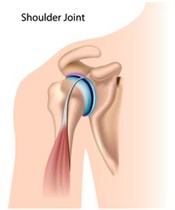

What is Frozen Shoulder?
Frozen shoulder, also known as adhesive capsulitis, is a condition characterized by pain, stiffness and loss of motion at the shoulder. The shoulder joint becomes inflamed, tight and stiff while adhesions may also develop. This condition can occur with or without a precipitating event such as an injury. Frozen Shoulder typically affects women more than men as well as an older population versus a younger population.
inflamed, tight and stiff while adhesions may also develop. This condition can occur with or without a precipitating event such as an injury. Frozen Shoulder typically affects women more than men as well as an older population versus a younger population.
There are three typical stages to Frozen Shoulder which include:
Freezing: Pain slowly increases while range of motion starts to become more and more limited. Noticeably, reaching overhead and behind the back becomes very difficult and painful. Tolerance to regular activities decreases due to pain and limited motion. This stage typically lasts from 6 weeks to 9 months.
Frozen: Stiffness and loss of motion continue but pain usually decreases. Daily activities that involve overhead reaching will most likely remain limited due to loss of motion. This may last for 4 to 6 months.
Thawing: Normal motion will slowly return but can typically take between 6 months to 2 years. Pain is noticeably decreased in this stage as regular activities become less limited.
Common Causes:
While frozen shoulder can happen with or without an injury, the causes are not well understood. However, there are some factors that may increase a person’s risk for developing frozen shoulder such as being an older woman, having diabetes, or recent shoulder immobilization after injury or surgery.
Diagnosis
To receive a diagnosis, a qualified musculoskeletal expert will first take a medical history and conduct a physical exam. Your doctor will test the range of motion in your shoulder. X-ray or MRI scanning may be required.
Treatment Options
While causes are not fully understood, there are various treatment options to consider depending on the individual and the stage of the Frozen Shoulder. An orthopedic surgeon will help to decide the treatment plan after an examination and discussion with the patient. For non-surgical treatment, physicians may prescribe anti-inflammatory medications such as ibuprofen or steroid injections such as cortisone to help reduce inflammation and pain. Intra-articular cortisone injections guided by fluoroscopy may help with rapid pain relief. Physical therapy will often be recommended. Physical therapists can help restore joint mobility, range of motion and strength while helping patients return to regular activities. When conservative treatment fails, surgical options include shoulder arthroscopy and manipulation under anesthesia in order to increase joint capsular mobility and range of motion.
While frozen shoulder can recur, most patients recover fully and do very well with conservative non-surgical interventions.
Copyright © www.orthopaedics.win Bone Health All Rights Reserved